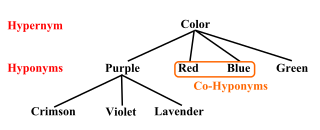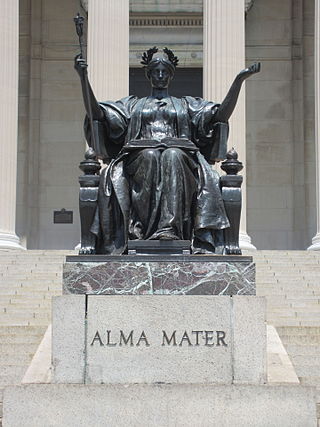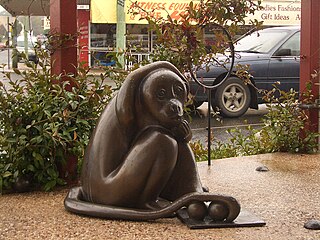
Charades is a parlor or party word guessing game. Originally, the game was a dramatic form of literary charades: a single person would act out each syllable of a word or phrase in order, followed by the whole phrase together, while the rest of the group guessed. A variant was to have teams who acted scenes out together while the others guessed. Today, it is common to require the actors to mime their hints without using any spoken words, which requires some conventional gestures. Puns and visual puns were and remain common.
In English, the phrase rule of thumb refers to an approximate method for doing something, based on practical experience rather than theory. This usage of the phrase can be traced back to the 17th century and has been associated with various trades where quantities were measured by comparison to the width or length of a thumb.
The comma, is a punctuation mark that appears in several variants in different languages. Some typefaces render it as a small line, slightly curved or straight, but inclined from the vertical, others give it the appearance of a miniature filled-in figure 9 placed on the baseline. In many typefaces it is the same shape as an apostrophe or single closing quotation mark ’.

Hypernymy and hyponymy are the semantic relations between a generic term (hypernym) and a specific instance of it (hyponym). The hypernym is also called a supertype, umbrella term, or blanket term. The hyponym is a subtype of the hypernym. The semantic field of the hyponym is included within that of the hypernym. For example, pigeon, crow, and hen are all hyponyms of bird and animal; bird and animal are both hypernyms of pigeon, crow, and hen.

Alma mater is an allegorical Latin phrase meaning "nourishing mother." It personifies a school that a person has attended or graduated. The term is related to alumnus, literally meaning "nursling," which describes a school graduate.

The V sign is a hand gesture in which the index and middle fingers are raised and parted to make a V shape while the other fingers are clenched. It has various meanings, depending on the circumstances and how it is presented.
In Modern English, the word "you" is the second-person pronoun. It is grammatically plural, and was historically used only for the dative case, but in most modern dialects is used for all cases and numbers.
Folk etymology – also known as (generative) popular etymology, analogical reformation, (morphological)reanalysis and etymological reinterpretation – is a change in a word or phrase resulting from the replacement of an unfamiliar form by a more familiar one through popular usage. The form or the meaning of an archaic, foreign, or otherwise unfamiliar word is reinterpreted as resembling more familiar words or morphemes.

The shaka sign, sometimes known as "hang loose" is a gesture with friendly intent often associated with Hawaii and surf culture. It consists of extending the thumb and smallest finger while holding the three middle fingers curled, and gesturing in salutation while presenting the front or back of the hand; the wrist may be rotated back and forth for emphasis. The shaka sign is similar to the letter Y in the American manual alphabet in American Sign Language or the sign for number six in the Chinese hand counting symbol. The shaka sign should not be confused with the sign of the horns, where the index and pinky fingers are extended and the thumb holds down the middle two fingers.
The term predicate is used in two ways in linguistics and its subfields. The first defines a predicate as everything in a standard declarative sentence except the subject, and the other defines it as only the main content verb or associated predicative expression of a clause. Thus, by the first definition, the predicate of the sentence Frank likes cake is likes cake, while by the second definition, it is only the content verb likes, and Frank and cake are the arguments of this predicate. The conflict between these two definitions can lead to confusion.

The OK gesture or OK sign or ring gesture is performed by joining the thumb and index finger in a circle, and holding the other fingers straight or relaxed away from the palm. Commonly used by scuba divers, it signifies "I am OK" or "Are you OK?" when underwater. In most English-speaking countries it denotes approval, agreement, and that all is well or "okay". In other contexts or cultures, similar gestures may have different meanings including those that are negative, offensive, financial, numerical, devotional, political, or purely linguistic.

The sign of the horns is a hand gesture with a variety of meanings and uses in various cultures. It is formed by extending the index and little fingers while holding the middle and ring fingers down with the thumb.

"Cold enough to freeze the balls off a brass monkey" is a colloquial expression used by some English speakers to describe extremely cold weather.

A taunt is a battle cry, sarcastic remark, gesture, or insult intended to demoralize or antagonize the recipient. Taunting can exist as a form of social competition to gain control of the target's cultural capital. In sociological theory, the control of the three social capitals is used to produce an advantage in the social hierarchy, to enforce one's position in relation to others. Taunting is committed by either directly or indirectly encouraging others to taunt the target. The target may give a response in kind to maintain status, as in fighting words and trash-talk.

An idiom is a common word or phrase with a figurative, non-literal meaning that is understood culturally and differs from what its composite words' denotations would suggest; i.e. the words together have a meaning that is different from the dictionary definitions of the individual words. By another definition, an idiom is a speech form or an expression of a given language that is peculiar to itself grammatically or cannot be understood from the individual meanings of its elements. For example, an English speaker would understand the phrase "kick the bucket" to mean "to die" – and also to actually kick a bucket. Furthermore, they would understand when each meaning is being used in context.

"Ride a Cock Horse to Banbury Cross" is an English language nursery rhyme connected with the English town Banbury in Oxfordshire. It has a Roud Folk Song Index number of 21143.

A hair's breadth, or the width of human hair, is used as an informal unit of a very short length. It connotes "a very small margin" or the narrowest degree in many contexts.













